A set is a collection of distinct objects. A universal
set, also called the universe, is the set of all objects under
consideration for a particular problem. Typically, ![]() is
used to represent the universe. If the set has many elements, we can define the
values specified by its conditions after a vertical bar. For example,
is
used to represent the universe. If the set has many elements, we can define the
values specified by its conditions after a vertical bar. For example, ![]() is a set. The vertical
bar means “such that.” If a set has only a few elements, we can directly list
all elements in a pair of curly braces. For example, a roll of a dice has 6
possible outcomes: 1, 2, 3, 4, 5, 6. Let’s define
is a set. The vertical
bar means “such that.” If a set has only a few elements, we can directly list
all elements in a pair of curly braces. For example, a roll of a dice has 6
possible outcomes: 1, 2, 3, 4, 5, 6. Let’s define ![]() and set
and set ![]() as all
the odd numbers in the universe:
as all
the odd numbers in the universe: ![]() . If an object is in a
set, it is an element of the set. The symbol
. If an object is in a
set, it is an element of the set. The symbol ![]() indicates set
membership and means “is an element of.” We have
indicates set
membership and means “is an element of.” We have ![]()
![]() and
and ![]()
The complement of a set ![]() ,
, ![]() is the set that
contains all the elements not in
is the set that
contains all the elements not in ![]() .
.
The union of two sets ![]() and
and ![]() ,
,![]() is the set that
contains all of the elements that are in either
is the set that
contains all of the elements that are in either ![]() or
or ![]() (or
both).
(or
both).
The intersection of two sets ![]() and
and ![]() ,
, ![]() , is the set that
contains all of the elements that are in both
, is the set that
contains all of the elements that are in both ![]() and
and ![]() .
.
The difference of sets ![]() and
and ![]() ,
, ![]() is the set of elements
in
is the set of elements
in ![]() but not in
but not in ![]()
![]()
The complement of ![]() is
is ![]() . Let’s define
. Let’s define ![]() as
all the numbers in the universe (of outcomes of a dice roll) that are larger
than 3,
as
all the numbers in the universe (of outcomes of a dice roll) that are larger
than 3, ![]() Then the union of
Then the union of ![]() and
and ![]() is
is ![]() the intersection is
the intersection is ![]() the difference is
the difference is ![]()
Two sets are mutually exclusive if ![]() where
where
![]() is an empty set.
is an empty set. ![]() and
and ![]() are always mutually
exclusive.
are always mutually
exclusive.
If all elements of ![]() are elements of
are elements of ![]() then
then
![]() is a subset of
is a subset of ![]() and
we denote the subset relationship as
and
we denote the subset relationship as ![]()
![]() is
read as “subset or equal to,” as
is
read as “subset or equal to,” as ![]() may have the same
number of elements as
may have the same
number of elements as ![]() If
If ![]() has
fewer elements than
has
fewer elements than ![]()
![]() is a
proper subset of
is a
proper subset of ![]() and we denote the
relationship as
and we denote the
relationship as ![]()
The principle of inclusion and exclusion (PIE) gives a formula for the number of elements in the union of ![]() and
and ![]() If
If ![]() is
the number of elements in
is
the number of elements in ![]() and
and ![]() is
the number of elements in
is
the number of elements in ![]() , then the number of
elements in the union
, then the number of
elements in the union ![]() , is the sum of
, is the sum of ![]() and
and ![]() minus
the number of elements in the intersection of A and B
minus
the number of elements in the intersection of A and B ![]() :
:
![]()
![]()
![]()
The Venn Diagram shows why the formula holds. When we sum the
number of elements in ![]() and the number of
elements in
and the number of
elements in ![]() , we count the elements
in the intersection of
, we count the elements
in the intersection of ![]() and
and ![]() twice.
Therefore, we need to remove the double counting to get the number of elements
in the union of
twice.
Therefore, we need to remove the double counting to get the number of elements
in the union of ![]() and
and ![]() .
.
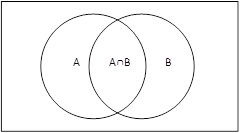
Figure 3‑14 Venn diagram of two sets
De Morgan’s laws: ![]()
![]()
Problem 3‑33
Assume that 200 students take the AP (Advanced Placement) chemistry class and 250 students take the AP biology class.
Part A. How many students, in total, take Biology and/or Chemistry if 50 students take both classes?
Part B. How many students take both classes if 370 students take either the AP chemistry class or the AP biology class, or both?
Solution:
For part A, we can apply the PIE equation ![]() Let A represent the
students who take the AP chemistry class in a high school, and B represent the
students who take the AP biology class in the same high school. The union of A
and B,
Let A represent the
students who take the AP chemistry class in a high school, and B represent the
students who take the AP biology class in the same high school. The union of A
and B, ![]() represents the students
who take either the AP chemistry class or the AP biology class. The
intersection of A and B,
represents the students
who take either the AP chemistry class or the AP biology class. The
intersection of A and B, ![]() represents the students
who take both AP chemistry and AP biology.
represents the students
who take both AP chemistry and AP biology.
![]()
Let’s explain the intuition behind the solution using the following Venn diagram:
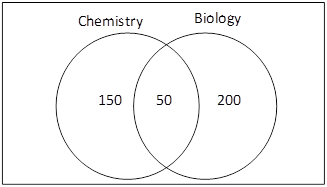
Figure 3‑15 Venn diagram of AP classes
Since 200 students take the AP chemistry class and 50 of them also take the AP biology class, 150 students take only the AP chemistry class. Since 250 students take the AP biology class and 50 of them also take the AP chemistry class, 200 students take only the AP biology class. Therefore, the number of students who take either class or both can be calculated as:
Students who take only chemistry + students who take only
biology + students who take both = ![]()
For the second question, we can again apply the PIE equation ![]() :
: ![]()
Let’s explain the intuition behind the solution using the following Venn diagram:
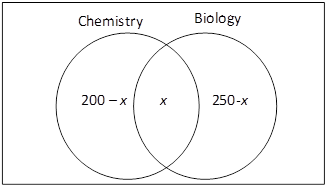
Figure 3‑16 Venn diagram of AP classes
Let’s assume that x students take both classes. The
number of students who take only the AP chemistry class is ![]() . The
number of students who take only the AP biology class is
. The
number of students who take only the AP biology class is ![]() .
Therefore, the number of students who take either class or both can be
calculated as:
.
Therefore, the number of students who take either class or both can be
calculated as:
Students who take only chemistry + students who take only biology + students who take both
= ![]()
General Rule: Use a Venn Diagram when solving problems involving unions and interactions of sets.
Now
let’s expand to three sets. The union of three sets A, B, and C,![]() is
the set that contains all of the elements that are in A, B or C. The
intersection of the three sets,
is
the set that contains all of the elements that are in A, B or C. The
intersection of the three sets, ![]() , is the set that
contains all of the elements that are in A, B, and C. For three sets, the
principle of inclusion and exclusion becomes:
, is the set that
contains all of the elements that are in A, B, and C. For three sets, the
principle of inclusion and exclusion becomes:
![]()
The Venn Diagram in Figure 3‑17 again shows why the
formula holds. When we sum the number of elements in A, B, and C, we double
count the elements in the subset represented by AB2, AC2, and BC2, and triple
count the elements in ABC3. To correct the overcounting, we need to deduct ![]() and
and ![]() once
and
once
and ![]() twice.
twice.
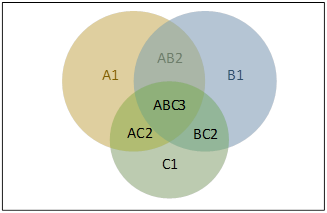
Figure 3‑17 Venn Diagram of three sets
From the diagram, we also have the following observations.
![]()
![]()
![]()
![]()
Therefore, we can calculate the elements in ![]() as:
as:
![]()
![]()
![]()
![]()
Problem 3‑34
Part A. ![]() is
an integer among
is
an integer among ![]() If
If ![]() is not
a multiple of
is not
a multiple of ![]() or
or ![]() how
many possible values can
how
many possible values can ![]() take?
take?
Part B. If ![]() is a multiple of 3 or 4
but not a multiple of 6, how many possible values can
is a multiple of 3 or 4
but not a multiple of 6, how many possible values can ![]() take?
take?
Solution:
In this problem, we combine the principle of inclusion and exclusion with
complementary counting. Instead of counting the number of integers that are not
a multiple of 3, 4, or 5, we can count the numbers that are a multiple of 3, 4,
or 5 first. Let ![]() be the set of the
integers that are divisible by 3,
be the set of the
integers that are divisible by 3, ![]() be the set of the
integers that are divisible by 4, and
be the set of the
integers that are divisible by 4, and ![]() be the set of the
integers that are divisible by 5.
be the set of the
integers that are divisible by 5. ![]()
![]() and
and ![]() are
the sets of the integers divisible by 12, 15, and 20, respectively.
are
the sets of the integers divisible by 12, 15, and 20, respectively. ![]() is
the set of the integers that are divisible by 60. We can use the floor
function[14]
is
the set of the integers that are divisible by 60. We can use the floor
function[14]
![]() to calculate the number
of integers that are divisible by another integer. For example,
to calculate the number
of integers that are divisible by another integer. For example, ![]() and the floor of
and the floor of ![]() is 666:
is 666: ![]() . There are 666 numbers
among
. There are 666 numbers
among ![]() that are divisible by
3. We have
that are divisible by
3. We have
![]()
![]()
![]()
![]()
Therefore, the number of ![]() that
are not multiples of 3, 4, or 5 is
that
are not multiples of 3, 4, or 5 is ![]()
To get the intuition behind the calculation, let’s draw a Venn
Diagram. As shown in Figure 3‑18, the circles labeled with 3×, 4×, and 5×
represent multiples of 3, 4, and 5, respectively. The intersection of 3× and 4×
is labeled 12× as the numbers are multiples of 12. Similarly, we have 15× and
20×. The centerpiece is the intersection of 3×, 4×, and 5×; it is labeled as
60× as the numbers are multiples of 60. Now let’s fill in the numbers for
different areas of the Venn Diagram. Typically, we start at the center, ![]() There are 33 multiples
of 60, so the number at the center is 33. Then we fill the spaces around the
center. For example, 166 numbers are multiples of 12. After we exclude
multiples of 60, there are 133 numbers in 12× (excluding 60×) area. Similarly,
we have 100 in 15× (excluding 60×) and 67 in 20× (excluding 60×). Then, we fill
the rest of the areas within the circles. When we add the numbers in these
different areas, we get 1200 numbers within the circles. Since there are 2000
numbers in the universal set, 800 numbers are out of the circles.
There are 33 multiples
of 60, so the number at the center is 33. Then we fill the spaces around the
center. For example, 166 numbers are multiples of 12. After we exclude
multiples of 60, there are 133 numbers in 12× (excluding 60×) area. Similarly,
we have 100 in 15× (excluding 60×) and 67 in 20× (excluding 60×). Then, we fill
the rest of the areas within the circles. When we add the numbers in these
different areas, we get 1200 numbers within the circles. Since there are 2000
numbers in the universal set, 800 numbers are out of the circles.
The Venn Diagram also provides us with the answer to part B. The
bottom three areas represent the numbers that are multiples of 3 or 4 but not
multiple of 5. Therefore, the total number of possible choices is ![]()
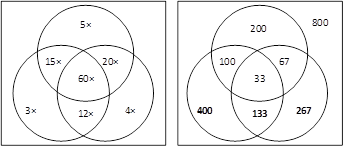
Figure 3‑18 Venn Diagram of integers divisible by 3, 4, or 5.
Problem 3‑35
««« How many rectangles are in Figure 3‑19?
Solution: This
problem is a combination of the number of rectangles from a regular shape and
inclusion-exclusion rules. We can separate the figure into three areas, a ![]() rectangle
on the left, a
rectangle
on the left, a ![]() rectangle (the middle
two rows), and another
rectangle (the middle
two rows), and another ![]() rectangle on the right.
The total number of rectangles with overcounting is
rectangle on the right.
The total number of rectangles with overcounting is ![]() Now we need to remove
the double counting. The overlap of the left
Now we need to remove
the double counting. The overlap of the left ![]() rectangle
with the
rectangle
with the ![]() rectangle is a
rectangle is a ![]() rectangle.
All rectangles in the overlapped
rectangle.
All rectangles in the overlapped ![]() rectangle are counted
twice. A
rectangle are counted
twice. A ![]() rectangle has
rectangle has ![]() rectangles. Similarly,
the overlap of the right
rectangles. Similarly,
the overlap of the right ![]() rectangle with the
rectangle with the ![]() rectangle
is a
rectangle
is a ![]() rectangle, which also
has
rectangle, which also
has ![]() rectangles counted twice.
The total number of overcounting is
rectangles counted twice.
The total number of overcounting is ![]() Therefore, after
correcting for overcounting, the total number of rectangles is
Therefore, after
correcting for overcounting, the total number of rectangles is ![]()

Figure 3‑19 Question: Number of rectangles
[14] Floor function takes a number as the input as outputs the greatest integer less or equal to the input number.